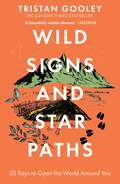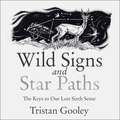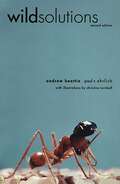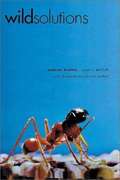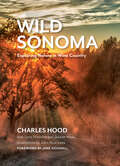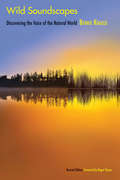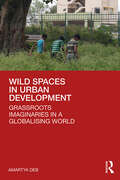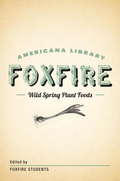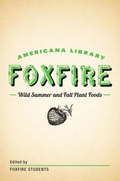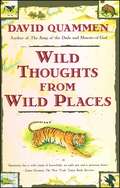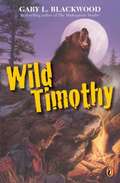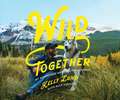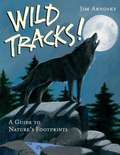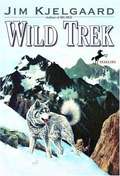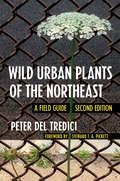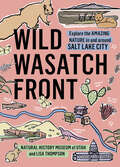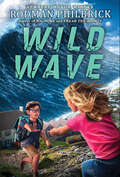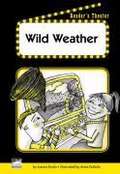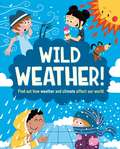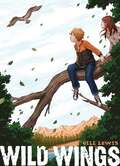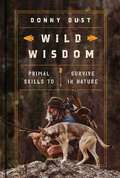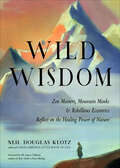- Table View
- List View
Wild Season
by Allan W. EckertA story of the living circle of nature Spring. A season of rebirth and struggle, destruction and survival. This is the story of one such spring at a Midwestern lake-a vivid closeup of each animal's fight for life, all under the shadow of the common enemy, Man. Shimmering with the enchantment of the natural world, Wild Season is a triumph of knowledge and love, raising our consciousness and stirring our sense of wonder and respect.
Wild Signs and Star Paths: 'A beautifully written almanac of tricks and tips that we've lost along the way' Observer
by Tristan Gooley'A paean to the beauty and majesty of nature, especially the nature we overlook in our back gardens and local parks... And like all the best books, it makes the world around you a lot more interesting' - Spectator'Beautifully written... I promise you will feel more in tune with the world around after reading only one chapter of Wild Signs and Star Paths, let alone the book in its entirety' - Royal Institute of Navigation'A beautifully written almanac of tricks and tips that we've lost along the way' - ObserverTristan Gooley, author of the internationally bestselling How To Read Water and The Walker's Guide to Outdoor Clues & Signs, shows how it is possible to achieve a level of outdoors awareness that will enable you to sense direction from stars and plants, forecast weather from woodland sounds and predict the next action of an animal from its body language - instantly.Although once common, this now rare awareness would be labelled by many as a 'sixth sense'. We have become so distanced from this way of experiencing our environment that it may initially seem hard to believe that it is possible, but Tristan Gooley uses a collection of 'keys' to show how everyone can develop this ability and enjoy the outdoors in an exciting way - one that is both new and ancient.
Wild Signs and Star Paths: 'A beautifully written almanac of tricks and tips that we've lost along the way' Observer
by Tristan Gooley'Beautifully written... I promise you will feel more in tune with the world around after reading only one chapter of Wild Signs and Star Paths, let alone the book in its entirety' - Royal Institute of Navigation'A beautifully written almanac of tricks and tips that we've lost along the way' - ObserverThe keys to enjoying the outdoors in an extraordinary way, one that is new and ancient.Tristan Gooley, author of the internationally bestselling How To Read Water and The Walker's Guide to Outdoor Clues & Signs, shows how it is possible to achieve a level of outdoors awareness that will enable you to sense direction from stars and plants, forecast weather from woodland sounds and predict the next action of an animal from its body language - instantly.Although once common, this now rare awareness would be labelled by many as a 'sixth sense'. We have become so distanced from this way of experiencing our environment that it may initially seem hard to believe that it is possible, but Tristan Gooley uses a collection of 'keys' to show how everyone can develop this ability and enjoy the outdoors in an exciting way - one that is both new and ancient.(P)2018 Hodder & Stoughton Limited
Wild Solutions
by Beattie, Andrew Ehrlich, PaulIn this fascinating and abundantly illustrated book, two eminent ecologists explain how the millions of species living on Earth -- some microscopic, some obscure, many threatened -- not only help keep us alive but also hold possibilities for previously unimagined products, medicines, and even industries. In an Afterword written especially for this edition, the authors consider the impact of two revolutions now taking place: the increasing rate at which we are discovering new species because of new technology available to us and the accelarating rate at which we are losing biological diversity. Also reviewed and summarized are many "new" wild solutions, such as innocative approaches to the discovery of pharmaceuticals, the "lotus effect", the ever-growing importance of bacteria, molecular biomimetics, ecological restoration, and robotics. "An easy read, generating a momentum of energy and excitement about the potential of the natural world to solve many of the problems that face us." E. J. Milner-Gulland, Nature "An engaging book clearly intended to impress upon a lay audience the practical value of biological diversity ... An outstanding work." Ecology
Wild Solutions: How Biodiversity Is Money in the Bank
by Paul R. Ehrlich Andrew BeattieIn this fascinating and abundantly illustrated book, two eminent ecologists discuss the biological diversity of the Earth, showing how the natural systems that surround us play an essential role in protecting our basic life-support systems.
Wild Sonoma: Exploring Nature in Wine Country
by Charles HoodAn all-access guide to the abundant natural splendor of Sonoma CountyWild Sonoma celebrates the spectacular and resilient natural landscapes of Sonoma County, which along with its neighboring counties is one of the world’s premier winegrowing regions. Our exploration launches with an entertaining primer on ecology basics, including the impact of fire, before a fun fact–filled survey of sixty-two of the area’s iconic and commonly encountered species—from vivacious acorn woodpeckers to disease-neutralizing Western fence lizards. It caps off with a tour of six sites to experience Sonoma’s diverse natural beauty, with a special emphasis on access. Written by Wild LA author Charles Hood, introduced by renowned naturalist Jane Goodall, and illustrated by John Muir Laws, Wild Sonoma offers residents and tourists from eight to eighty a sense of wonder and cause for hope.
Wild Soundscapes: Discovering the Voice of the Natural World, Revised Edition
by Bernie Krause Roger PayneWild Soundscapes is the first comprehensive guide to listening to--and recording--nature. Learn how to tune in to nature's biophonies, or creature symphonies; how to use simple microphones to hear more; and how to record, mix, and play with sounds you gather. Keep it simple or launch yourself into a new creative field. Whether you're an amateur naturalist, novice field recordist, musician, want to create your own natural sound library, or just want to gain further appreciate of the natural world, this is the book for you. Bernie Krause, a professional field recordist and bioacoustician, shares his expertise in exploring nature's sonic landscapes. Wild Soundscapes comes with a full-length CD, narrated by Krause, sampling a variety of natural sounds: the crashing sea, the singing of ants, the bugling of Yellowstone elk, the plop of falling Costa Rican crabs, and more. With the help of this CD, Krause demonstrates techniques and tricks for field recording success.
Wild Spaces and Unique Places: Celebrating the Natural Wonders of Utah
by Ryan JefferyWith its sweeping valleys and towering mountains, its inviting summers and glittering snowscapes, its hiking trails and world-renowned ski slopes, Utah’s soaring heights are, indeed, where life is elevated. Explore these wild spaces through the dramatic and captivating photography of Ryan Jeffery, which captures Utah’s beloved wildness—the wildlife, the national parks, the desert vistas, and the mountains, all beautifully arrayed in splendor. Quotes from Utah authors such as Terry Tempest Williams, Edward Abbey, and Everett Ruess are spread throughout the scenes. Each page whisks you away to spaces like no other—where open skies kiss the silhouette of the landscape that rises to meet it.
Wild Spaces in Urban Development: Grassroots Imaginaries in a Globalising World
by Amartya DebThis fascinating book examines how microsites of spontaneous nature can reframe our understanding of the relationship between urban development and green space. Metropolitan cities are facing stark inequalities of green space distribution, hindering goals of sustainable development. But outside of human control, spontaneous nature grows in spaces that are neglected or are unaccounted for. Drawing on existing literature and primary research in a range of towns and cities, including Quito in Ecuador, Bengaluru and Kolkata in India, and Whitby in the United Kingdom, the book delves into the morphology, meanings, and values of those small-scale assemblages of wild growth which are typically overlooked. Discussing instead how such settings can be integrated into everyday urban life, the book offers a fresh perspective on issues around green infrastructure, heritage conservation, and environmental education, enabling cities worldwide to become more nature-positive. A unique examination of an under-researched topic, this book will appeal to students, researchers, and professionals across landscape architecture, urban planning, urban ecology, and all related fields.
Wild Spring Plant Foods: The Foxfire AMericana Library (7) (The Foxfire Americana Library)
by Inc. Foxfire FundA handy illustrated guide to the edible plant life available in Appalachia and other temperate areas during the spring. From sassafras to rhubarb, each entry includes instructions on where to find the plant, how to spot it, and the ways it is best eaten, often with recipes. Plants include: MorelAsparagusWild onionWild garlic NettlesWild radishWhite mustardWater cressHorseradishChicoryWild lettuceDandelion
Wild Summer and Fall Plant Foods: The Foxfire Americana Library (8) (The Foxfire Americana Library)
by Inc. Foxfire FundA handy illustrated guide to the edible plant life available in Appalachia and surrounding areas during the summer and fall seasons. From berries to herbs perfect for teas and tonics, each entry includes information on where to find the plant, how to spot it, and the best ways to eat it, often with recipes. Plants include: GooseberriesRaspberriesBlueberriesFigsPawpawsCattailsNutgrassThistleCatnipSpearmintPeppermintBlue-mountain teaYarrowChamomile DillsBlack WalnutsPecansHazelnuts
Wild Thoughts from Wild Places
by David QuammenIn Wild Thoughts from Wild Places, award-winning journalist David Quammen reminds us why he has become one of our most beloved science and nature writers.This collection of twenty-three of Quammen's most intriguing, most exciting, most memorable pieces takes us to meet kayakers on the Futaleufu River of southern Chile, where Quammen describes how it feels to travel in fast company and flail for survival in the river's maw. We are introduced to the commerce in pearls (and black-market parrots) in the Aru Islands of eastern Indonesia. Quammen even finds wildness in smog-choked Los Angeles -- embodied in an elusive population of urban coyotes, too stubborn and too clever to surrender to the sprawl of civilization.With humor and intelligence, David Quammen's Wild Thoughts from Wild Places also reminds us that humans are just one of the many species on earth with motivations, goals, quirks, and eccentricities. Expect to be entertained and moved on this journey through the wilds of science and nature.
Wild Timothy
by Gary L. BlackwoodThirteen-year-old Timothy, more interested in reading than in physical activity, reluctantly accompanies his enthusiastic father on a camping trip and, when he accidentally becomes lost in the woods, discovers that he is capable of surviving on his own.
Wild Together: My Adventures With Loki The Wolfdog
by Kelly LundFor all lovers of dogs and adventure, come experience Kelly and Loki the Wolfdog’s world together, as they explore the country and inspire those around them, revealing the endless possibilities between a man and his four-legged companion. During a blizzard in 2012, Kelly brought Loki—a husky/arctic wolf/malamute mix—home. Growing up in a family that took dog ownership very seriously, Kelly had his fair share of experiences with large dogs. But Loki was different. Instead of the dog entering into Kelly’s world, Kelly felt that he had to listen closely to Loki and enter into his world. At that time, Kelly decided that he would do everything possible to not leave him behind at the house. They started backcountry snowboarding together when Loki was four months old, and before his third birthday, he’d seen most of the western United States. Loki the Wolfdog has developed a massive following across social media. With 1.5 million followers on Instagram and 140,000 likes on Facebook, people have grown to love following Kelly and Loki’s adventures. Starting out just for fun, Kelly started an Instagram account for Loki documenting their escapades. The story was later picked up by numerous websites, giving them unexpected exposure. Realizing that they now have a voice in the social media community, they want to give back and inspire others to get out, explore the world, and make memories with their pups. Loki the Wolfdog has a massive following, because people have enjoyed watching Kelly and Loki’s undeniable bond. The story is both philosophical and visual: an invitation to experience life through Kelly and Loki’s eyes.
Wild Tracks!: A Guide to Nature's Footprints
by Jim Arnosky<P>When children learn to recognize and read animal tracks they're actually mastering an ancient language of shapes and patterns--and gaining knowledge of the natural world. <P>This is the perfect gift for a budding naturalist, animal lover, or artist. Jim Arnosky has been honored for his overall contribution to literature for children by the Eva L. Gordon Award and the Washington Post/Children's Book Guild Award for nonfiction. Many of his books have been chosen as ALA Notable Books, including Drawing from Nature, a Christopher Award-winner. Wild Tracks! is Jim's 100th book for children. Image descriptions present.
Wild Trek
by Jim KjelgaardAN UNFORGETTABLE SAGA OF COURAGE AND SURVIVAL. This is the story of the trapper, Link Stevens, and his fearless snow dog, Chiri. It began when the trapper and his dog set out to rescue a naturalist stranded in the perilous Caribou mountains — the impenetrable storm-blasted heights from which no man has ever returned. Forced to live by Stone Age methods, they relied on every resource of the dog’s wild cunning and the trappers woodlore. How they battled a killer cougar and bloodthirsty wolves, yet brought their man to safety, is a gripping, action-packed saga. It is also the stirring tale of the deep love between a loyal snow dog and his courageous trapper master.
Wild Urban Plants of the Northeast: A Field Guide
by Peter Del TrediciIn this field guide to the future, esteemed Harvard University botanist Peter Del Tredici unveils the plants that will become even more dominant in urban environments under projected future environmental conditions. These plants are the most important and most common plants in cities. Learning what they are and the role they play, he writes, will help us all make cities more livable and enjoyable. With more than 1000 photos, readers can easily identify these powerful plants. Learn about the fascinating cultural history of each plant.
Wild Visions: Wilderness as Image and Idea
by Stephen J. Pyne Ben A Minteer Mark KlettA stunning combination of landscape photography and thematic essays exploring how the concept of wilderness has evolved over time Our ideas of wilderness have evolved dramatically over the past one hundred and fifty years, from a view of wild country as an inviolable &“place apart&” to one that exists only within the matrix of human activity. This shift in understanding has provoked complicated questions about the importance of the wild in American environmentalism, as well as new aesthetic expectations as we reframe the wilderness as (to some degree) a human creation.Wild Visions is distinctive in its union of landscape photography and environmental thought, a merging of short, thematic essays with a striking visual narrative. Often, the wild is viewed in binary terms: either revered as sacred and ecologically pure or dismissed as spoiled by human activities. This book portrays wilderness instead as an evolving gamut of understandings, a collage of views and ideas that is still in process.
Wild Wasatch Front: Explore the Amazing Nature in and around Salt Lake City (Wild Series)
by Natural History Museum of UtahA vibrant, informative guide to the unexpected nature in Salt Lake City and the surrounding area. Set out on a field trip with the experts from the Natural History Museum of Utah. In this book, you&’ll learn about over 100 local species, both plants and animals. Be on the lookout for painted turtles in Ogden, spot pelicans soaring over Provo, and identify pavement mushrooms in Salt Lake City. Equal parts field guide and trip planner, Wild Wasatch Front reveals the unexpected nature thriving in parks, beside urban streams, along local trails… and maybe even in your own backyard.
Wild Wave (The Wild Series)
by Rodman PhilbrickAnother WILD adventure from Rodman Philbrick, author of Wildfireand Wild River. Wild Wave is the adventure of two kids trapped in the aftermath of a tsunami. It's kids vs. nature in another edge-of-your seat read!When a tsunami heads for the coast, Nick Chase and Jess Hardy have to run. They make it into the woods above the bay--only to see the sea flooding their whole neighborhood along the shore. Destroying everything.In the broken landscape that's left behind, the two must try to find their way to safety. But when they come across a stranded elderly couple, it's up to Nick and Jess to work together and get help so that they can all make it out alive.This is another gripping environmental survival story from the Newbery Honor author of Wildfire and Wild River.
Wild Weather
by Joanna Korba Jeffrey Fuerst Anita DufallaPerform this script about how to change the weather.
Wild Weather: Find out how weather and climate affect our world
by Liz GogerlyWeather is awesome and exciting - it's part of our everyday lives but what is it? This funkily illustrated title explores all types of weather with four children Anjali, Lulu, Mason and Noah. Their teacher, Mr Sangar, explains that weather is about what's happening in the atmosphere. And, there are six major things going on up there that are constantly changing and making our weather. Mason's dad explains the water cycle to them. They experience all types of weather, such as rain, snow, sleet and hail and see some fantastic rainbows too. They learn about extreme weather, such as floods, hurricanes and typhoons and find out how to identify different types of clouds and lightning. They discover the different climate zones, learn about jet streams and get serious about climate change and global warming.Get Busy activity suggestions encourage children to be actively engaged.There are also full-page, step-by-step activities for how to make a cloud burst or a tornado in a jar.Look out for the other titles in this series: Go Green!, Nature Needs You! and Save the Seas!
Wild Wings
by Gill Lewis Yuta OnodaThe majestic Osprey is an endangered bird that hasn't been seen in Scotland for years, so when Iona McNair locates an Osprey nest, she's desperate to keep the bird safe from poachers. She shares her secret with her classmate Callum, and the two become friends as they work to save the Osprey they've named Isis. They're able to get the bird tagged by a preservationist, but after Isis flies to Africa for the winter, her signal becomes stagnant, then lost. Spurred by a promise to Iona, who has fallen ill, Callum is determined to track and save Isis, and a leap of faith and the magic of e-mail connects him with a girl in Gambia who can help him make good--in more ways than one. Set against the dramatic landscapes of Scotland and West Africa, this is a timeless tale of hope and friendship--a heartwarming novel infused with the beauty of nature.
Wild Wisdom: Primal Skills to Survive in Nature
by Donny DustSurvive anything nature throws your way with these survival tips and wilderness philosophy from renowned outdoorsman and now beloved TikTok star Donny Dust.Donny Dust is a US Marine Corps veteran who now owns and operates Colorado&’s premier survival and wilderness self-reliance school. He&’s amassed two decades worth of primitive living skills everywhere from the jungles of Asia to the mountains of North America. He&’s appeared on reality TV series like History Channel&’s Alone and hosted USA Channel&’s Mud, Sweat & Beards. Now, Donny brings all he&’s learned to Wild Wisdom. He teaches you how to be more observant to help avoid danger, problem-solve, prioritize finding shelter, and to be flexible and creative when you need the right supplies for a task. He also focuses on essential gear, sheltering, building fire, staying hydrated, food, foraging, and trapping. Beautiful and instructive illustrations throughout make this is must-carry for anyone venturing into nature. Millions of people now follow Donny Dust on TikTok to watch him craft objects from nothing but what he finds in the wilderness. Even the tools he uses to do the crafting are made from scratch, whether it&’s a saw, chisel, hammer, or cordage. He&’s made bows, arrows, axes, rope, sandals, backpacks, bowls, swords, and of course, fire—lots of fire—but Wild Wisdom offers so much more. Written by one of the country&’s foremost experts, it&’s a book for almost anyone, whether you&’re a longtime outdoorsperson hoping to hone your skills and deepen your appreciation and understanding of the wilderness, or a newcomer looking to take your first adventures in nature.
Wild Wisdom: Zen Masters, Mountain Monks & Rebellious Eccentrics Reflect on the Healing Power of Nature
by Neil Douglas-KlotzInspiration from wilderness mystics from around the world, including Henry David Thoreau, Bai Juyi, Rainer Maria Rilke, Lalla, Rachel Carson, and more.Sages and mystics throughout the centuries have sought inspiration in the wildness of nature. This little book gathers the sayings and stories of the women and men who have sunk their roots deep into inner retreat and brought forth wisdom for all times and peoples.Here we find the stories and voices of desert fathers and mothers, forest hermits, mountain mystics, wandering philosophers, and wise eccentrics who maintained their solitude while living in society and challenged the status quo with humor. From East and West and everything in between. From Christian hermits, wandering Kabbalists, itinerant Sufis, Zen practitioners, Yogis, court jesters, transcendentalists, and freethinkers, Wild Wisdom gathers a timeless harvest for spiritual renewal.By turns witty, startling, beautiful, and sublime, Wild Wisdom makes a fine companion for personal retreat, daily contemplation, or simply taking time out during a busy day.

